Local living and 20 minute neighbourhoods - planning guidance: consultation
We are seeking views on this draft guidance on local living and 20 minute neighbourhoods to support the implementation of National Planning Framework 4 (NPF4).
Part 3 - Ways to Support Local Living and 20 Minute Neighbourhoods
Structuring the approach
In delivering local living, whether through the planning system or more broadly, three key steps are recommended:
1. Understand context - understanding the context of the place through the use of quantitative and qualitative information.
2. Collaborate, plan, design - developing collaborative models of working to inform place-based planning and design processes.
3. Implement and review - aligning investment, developing delivery capacity and supporting new ways of working.
Delivering local living will most often be part of an incremental approach and the above steps may be repeated as part of an ongoing, iterative process.
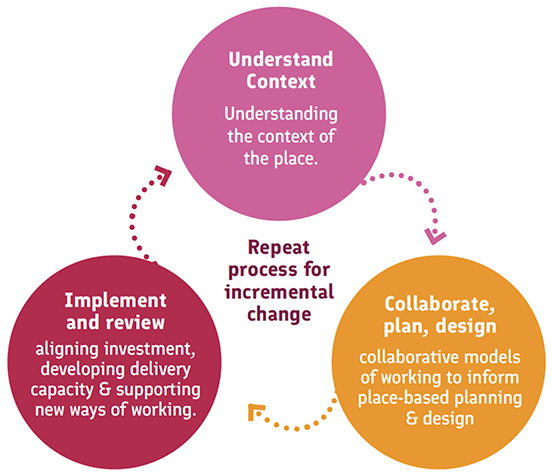
Understand context
To improve, develop and change a place there first must be a thorough understanding of the context as a starting point. This can be developed through the study of the unique circumstances and characteristics of a place; the settlement patterns; the density and scale; connectedness or remoteness; historical, natural, physical and social assets; existing resources, services and facilities, including any changes that are planned and the policy context.
Once gathered this information can be referenced by the LDP Evidence Report, to help inform decisions about future development.
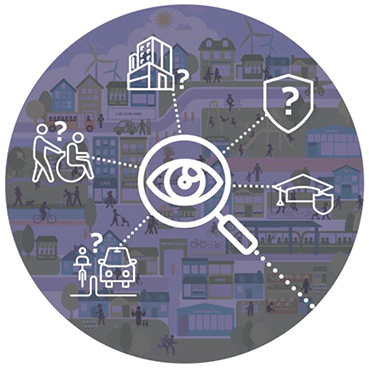
Data collection is essential in understanding the context of our places. Data should be both quantitative and qualitative, to ensure that local views are considered alongside statistics and hard data.
Multiple quantitative data sources are available and can be layered, overlapped and cross referenced to offer valuable information about a place. Gathering qualitative data enhances the range and depth of information, helping to understand community perspectives.
The following types of data can be utilised to build the picture of a place and in the measuring of progress against an initial or established baseline:
- Quantitative data: to assess existing, previous and future land uses, transport connections and patterns of behaviour in relation to daily needs. This often involves spatial mapping and digital resources such as GIS - Geographic Information Systems.
- Qualitative data: to collect the views of the local community, businesses and service providers in an area. This can provide an important picture of the experience of people living within an area and views on the quality of the local environment. Assessment methodologies such as the Place Standard tool and other community engagement processes can be useful in gathering qualitative data, helping to capture the picture of lived experience in a place.
The following sections provide further detail on place-specific qualitative and quantitative information gathering in support of local living and 20 minute neighbourhoods.
Quantitative data
Quantitative data gathering in relation to local living is a way of identifying and mapping what already exists to meet people's daily needs sustainably. This includes:
- Facilities, services, and amenities required for daily life.
- People's ability to access these features locally using safe, high-quality walking, wheeling, and cycling networks and sustainable modes of transport.
Some of the facilities, services and amenities will be buildings or places that people visit and can therefore be located precisely using GIS mapping, for example, schools, play parks, food shops and GP surgeries. Other qualitative data important to consider in delivering local living includes:
- Access to work: employment opportunities can take many forms including working from home, utilising local office and workshop space, co-working space, and business support functions.
- Access to housing: building a picture of the housing mix, demand, tenures and quality in an area is an important consideration for local living. This supports planning to deliver appropriate good quality housing at appropriate scales and densities, can help tackle rural depopulation and enable people to be able to be remain in their community as they grow older.
- Access to digital services: the provision of services using digital methods and means is increasing and becoming increasingly vital in supporting home working and businesses.
- Access to transport and connectivity: mapping can record the location, type and frequency of sustainable transport options and walking distances to key locations as well as providing important information on public transport access and car use.
Digital mapping can illustrate the range of daily needs accessible to particular streets or areas within a reasonable walk, wheel or cycle. This valuable data can then be used to develop options to improve access to services and to help direct investment in future facilities or projects.
It is important to remember that the 20 minute journey time may vary locally between communities, according to circumstance. What matters is enabling local liveability, convenience and accessibility for local people in a sustainable manner.
The realities of longer travel times and distances in remote locations, and expectations of accessibility, may differ from more densely populated areas. Digital mapping can be useful in providing various scenarios to help inform and engage communities on the opportunity and limitations to access to daily needs and support local living.
Digital mapping can also be used to make comparisons with other datasets such as Scottish Index of Multiple Deprivation, Census data and many other national and local spatial datasets.
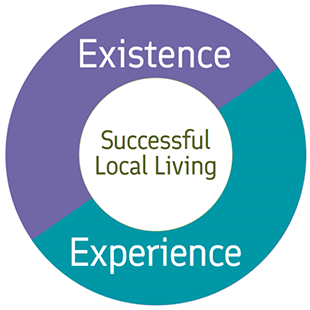
Qualitative data
When considering local living it is important not only to capture information on the range, diversity and access to daily needs within an area, but also to understand the extent to which services meet local need and the experience involved in accessing them.
For example:
- There may be access to shops, but do they provide for local needs; healthy food where there is a deficit, for example?
- Services and facilities may be accessible, but are the routes to them safe and attractive? Does the quality of the environment encourage people to walk.
- Are services inclusive and accessible to all members of the community? Are there hidden barriers that prevent people accessing their needs?
Through approaches that involve gathering of qualitative information we can assess how well people's daily needs are met. Qualitative data may be more complex to gather, but it can draw out key information about the things in a place that are important and contribute to ability of a community to thrive. Issues such as the identity and sense of belonging, history and culture, community aspirations, perceptions of safety and opportunities to participate effectively in community life are all important considerations in supporting local living.
Community engagement
Many communities will already have been part of or undertaken community engagement relating to the future of their place. This might be through:
- Community action plans
- Locality Plans and other Community Planning exercises
- the Local Development Plan
- regeneration work such as town centre plans, area masterplans and community-led design processes
- community development initiatives
The results of previous engagement exercises like these can form a valuable starting point for qualitative information on people's access to daily needs, minimising duplication and cost.
The qualitative data and information gained through tools such as the Place Standard, combined with new and prior community engagement exercises, is an essential complement to quantitative data to create a rounded picture and a baseline for how well daily needs can be accessed sustainably in any community.
Developing a good understanding of the relationship between quantitative and qualitative information is crucial to successful delivery of local living and supports informed and joined-up planning and design processes.
Collaborate, plan, design
Informed decision making and integrated processes
Collaboration
The daily needs of people in a place do not fit neatly within one service, department or sector. Local living requires input from a broad range of stakeholders and a cross sector commitment to collaborative working, including supporting;
- the Place Principle, eradicating silo working and aligning investment, development delivery capacity and resources.
- community engagement to understand and shape local priorities to deliver the benefits of local living.
- collaboration between local communities, local authorities and Community Planning Partners.
- flexibility and adaptability to accommodate shifting priorities.
- public service reform, to deliver effective preventative spend and partnership working.
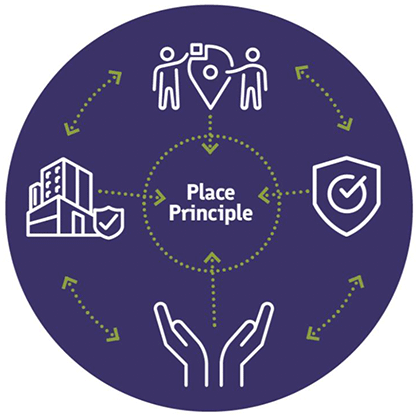
Planning and design
Land-use planning is a fundamental tool for embedding local living and 20 minute neighbourhood principles in our places. NPF4 provides a new approach to planning by combining the long term spatial strategy with national planning policies to form part of the statutory development plan.
Policy 15 of NPF4 sets out an expectation for local development plans to support local living, including 20 minute neighbourhoods within settlements, through the spatial strategy associated site briefs and masterplans.
Planning authorities are ideally placed to gather the quantitative and qualitative data that is essential to plan and deliver local living as part of the Evidence Report stage of LDP preparation. LDP policies, proposals and allocations, informed by the principles of good place making, can help to focus investment in buildings and places that deliver sustainable and healthy communities.
This information can then help to inform the development of the plan's spatial strategy and associate allocations of sites for development, at the proposed plan stage. Options and alternatives could be used to explore how best to achieve local living in a way that responds appropriately to the context and characteristics of the plan.
Collaborative approaches can also realise opportunities for combining investment to improve outcomes through locational choices within a plan, for example;
- Climate adaptation work in a place may provide opportunities to improve active travel or deliver multifunctional greenspace and biodiversity benefits;
- The location of new public buildings such as schools or council offices may support town centre regeneration and increase footfall for local businesses. The clustering and concentrating of services may reduce overall travel distances costs and times in accessing services.
- Can the location and density of new housing improve the viability of local services as well as meeting local housing need?
The principles of local living and 20 minute neighbourhoods will be important considerations in community-led initiatives including Local Place Plans and, in turn, will play a key role in supporting local living in LDPs.
Leadership at a local level is a strategic component in the delivery of local living and 20 minute neighbourhoods as evidenced in many of the recent examples of successful roll out of similar concepts across the world.
Implement and review
As well as understanding context and planning accordingly, delivering local living and 20 minute neighbourhoods involves coordination across investment plans and opportunities.
The commitment to support local living has been bolstered with the alignment of a number of cross government policies, strategies and investments that can support local delivery including NPF4, the Place Based Investment Programme, the Empowering Communities Programme, Town Centre Action Plan and Town Centre First Principle, Community Wealth Building, Housing to 2040, Climate Action Towns, the Infrastructure Investment Plan, investment for Active Travel and the Work Local Challenge Programme.
Different organisations and sectors have knowledge and skills and the ability to tap into resources and funding that others cannot. Community organisations and the third sector have essential local knowledge, insights and capacity. Local authorities have professional expertise, statutory powers and responsibilities, and regulatory roles related to many daily needs. The private sector is highly effective at making things happen, creating jobs and realising opportunities.
Each sector can support others to access resources and help share capacity and knowledge. Not only is this vital to make effective use of limited resources and capacity for delivery, it will also help to maximise the benefits of local living, developing co-benefits and supporting community wealth building.

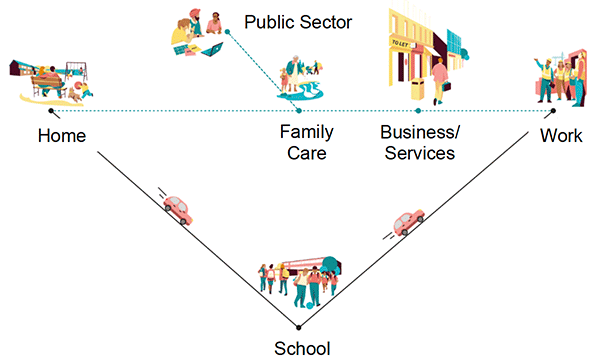
Everyone involved in making decisions about a place should ensure that actions are informed by considering the wider impacts and capturing co-benefits.
The concept is also applicable (where relevant) to planning decisions. Planning authorities are expected to apply planning judgement in determining whether or not planning applications are supported, or not, by Policy 15. To assist with this, applicants should be prepared to demonstrate how the proposal responds to its context including the existing settlement pattern and the level and quality of interconnectivity of the proposed development with the surrounding area. Policy 15 also sets out a list of considerations to help establish this, but it is recognised that their relevance will vary between applications and contexts. Over time, local living will be embedded within local development plans, providing a further steer on expectations for applications.
Review and monitoring should be undertaken to understand where further action is required, to listen and respond to feedback, to update plans and delivery models and to take advantage of new opportunities. This involves revisiting and updating the assessment of context and quantitative and qualitative data, as well as taking into account emerging community plans and activity. The most appropriate solutions for monitoring and review are likely to emerge through sharing of good practice and experience during the lifetime of this guidance.
Contact
Email: localliving&20mn@gov.scot
There is a problem
Thanks for your feedback